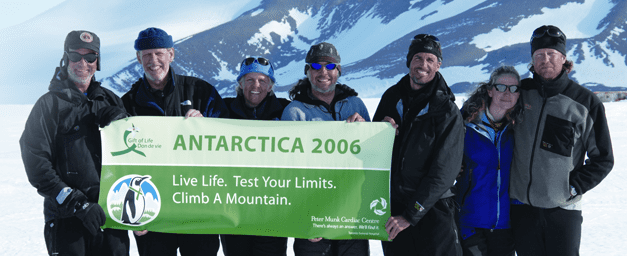We did it.
Together, we saved a life. Quite literally, our donors’ generosity has made a difference. And David Prince is living proof.
Mr. Prince, while vacationing in Brazil, had a massive heart attack in January 2007. He was treated and stabilized in Brazil and came home. Upon arriving in Toronto, he was clearly still critically ill. He was seen in the Heart Function Clinic on March 21st, 2007, and admitted straight into the intensive care unit. David underwent mechanical circulatory support with a HeartMate II device on March 28th, and was discharged home just three weeks later. The device allowed him to recuperate from his severe illness and made him stronger for his transplant. A donor heart became available and David underwent successful transplant on May 11th. He was discharged home 12 days later in excellent condition.
Thanks to generous donor support of the Heart Failure and Cardiac Transplant Program at Toronto General Hospital, David is alive and well – and already working on his golf game!
Initiatives such as Antarctica 2006: Live Life – Test Your Limits and donor support of the Heart Failure, Ventricular Assist Device, and Heart Transplant Programs as well as new therapies such as Cardiac Regenerative Medicine, are what provide the crucial funding that enable us to strive toward new and cutting-edge Replacement Therapies for Advanced Heart Failure.
Donor support of the Antarctica 2006: Live Life – Test Your Limits adventure was phenomenal. Through Antarctica 2006, we generated net proceeds of $1,000,000, and we are building on that with “Nepal 2008.”
RELIVE THE ADVENTURE: READ THE BLOG
The Team
[one_third]
Ian W. Delaney[/one_third]
[one_third_last]
Dr. Patricia Murphy[/one_third_last]
[one_third]
Dr. Heather Ross
MD, MHSC, FRCP(C)[/one_third]
[one_third_last]
Dale Shippam
Heart Transplant Patient[/one_third_last]
Quick Facts: Antarctica
Antarctica covers an area of 14,000,000 Sq. Km, or 1/10th of the land surface of the planet. It is the fifth largest land mass.
Contrary to the widely held belief that the continent is a low elevation, flat land mass, consider that it is the highest overall continent with a mean altitude of 2,050 meters above sea level
It is considered the world’s coldest desert and receives very little precipitation. In the “dry valleys” some scientist believe that no rain has fallen in 2 million years
The Cold: From 10°C in summer to -89.6°C or -128.6°F (the lowest air temp ever recorded.) In the winter extreme, metal can stick to skin, kerosene turns to jelly and fillings can fall out of teeth
The Wind: The cold of the interior, the domed shape of the continent and intense low pressure systems around the coast combine to create Antarctica’s powerful katabatic winds, some of the strongest winds on earth, often exceeding hurricane force (120 km/h) for several days at a time. Maximum gusts of more than 250 km/h have been recorded
The Real Estate:
- Total area: 14 million sq. km (just under 1½ times the US)
- Arable land: 0%
- Permanent crops: 0%
- Meadow, pasture: 0%
- Forest, woodland: 0%
- Other: 100% (ice 98%, barren rock 2%)
We Knew It Had To Be Somewhere: 90% of the world’s ice (29 million cubic km) and 60-70% of its fresh water is in the Antarctic ice cap


No responses yet